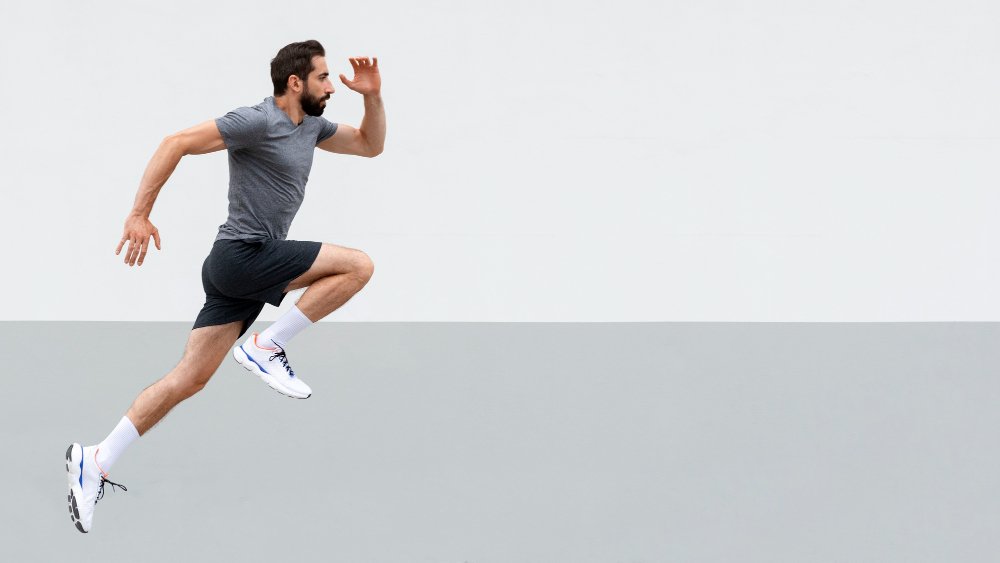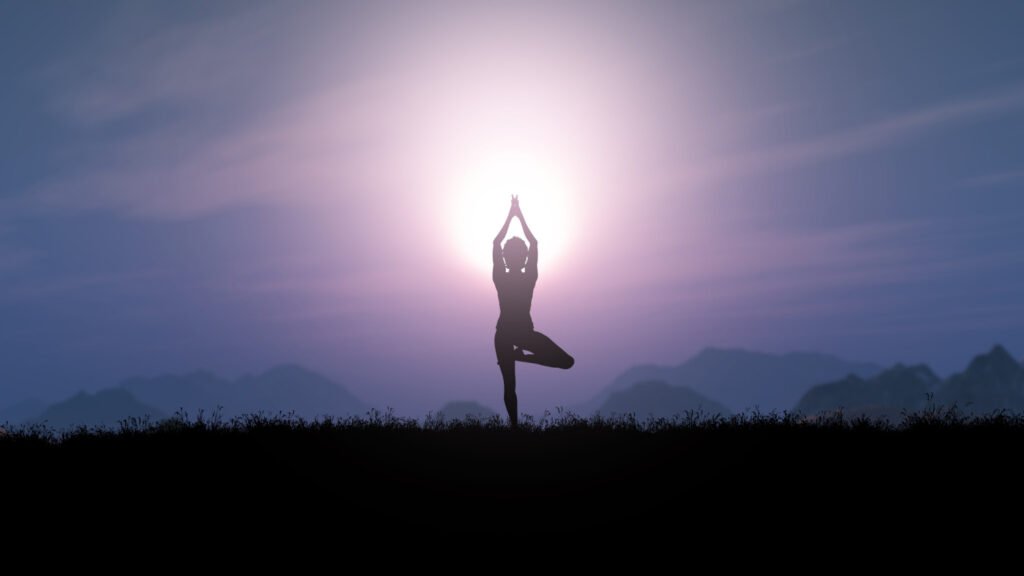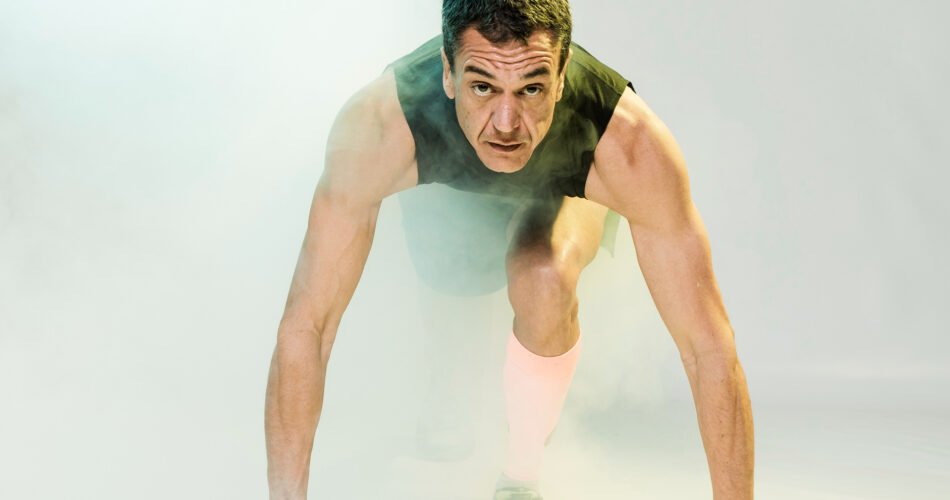“Yoga is the journey of the self, through the self, to the self.” – The Bhagavad Gita
Introduction
Running is an extraordinary method for remaining in shape, however, it can likewise negatively affect your body. Indeed, even experienced sprinters can experience the ill effects of wounds brought about by redundant running movement. This is where yoga comes in. Yoga can assist sprinters with working on their presentation and forestall injuries by expanding adaptability, strength, and equilibrium. Here, we will investigate the advantages of yoga for sprinters and give you some straightforward yoga represents that you can integrate into your daily running practice. Whether you’re a carefully prepared long-distance runner or simply beginning, these yoga postures will assist you with working on your exhibition, forestall wounds and keep you feeling perfect. So carry out your yoga mat, ribbon up those running shoes, and how about we get everything rolling?

1. Importance of Yoga in Running
When it comes to improving performance and preventing injuries, running and yoga may seem like two completely different activities. However, yoga can be an incredibly beneficial addition to any runner’s training routine.
First and foremost, yoga can help improve flexibility and mobility, which are important for runners as tight muscles and a limited range of motion can lead to injuries. Yoga postures, such as lunges, downward dog, and pigeon pose, can stretch out and lengthen muscles in the legs, hips, and back, helping to prevent strains, sprains, and other injuries that can be caused by overuse or repetitive motion.
In addition to the physical benefits, yoga can also help runners improve mental focus and clarity. The mindfulness and breathing techniques taught in yoga can help runners stay present at the moment, focusing on their form, breathing, and stride, which can lead to better performance on the track or trail.
Overall, incorporating yoga into a running routine can help runners improve flexibility, prevent injuries, and enhance mental focus, all of which can lead to better performance and a more enjoyable running experience.
2. Benefits of Yoga for Runners
Yoga is a great way for runners to improve their performance and prevent injuries. Incorporating yoga into your training routine can significantly improve your running by strengthening the muscles that are often underutilized by running, such as the hips, glutes, and core. It can also help to improve your flexibility and balance, allowing your body to move more efficiently and reducing the risk of injury.
One of the main benefits of yoga for runners is that it can help to increase your range of motion. Running can cause tightness in the muscles, particularly in the hips and hamstrings, which can lead to imbalances in the body and potentially cause injury. Practicing yoga regularly can help to counteract this by improving flexibility and joint mobility.
Yoga can also help to improve your breathing, which is essential for runners. By practicing deep breathing techniques during yoga, you can learn to control your breath and increase your lung capacity, allowing you to breathe more efficiently while running.
Additionally, yoga can help to reduce stress and improve mental focus, which can be beneficial for runners who are training for a race or looking to improve their performance. By incorporating mindfulness and meditation into your yoga practice, you can learn to stay present and focused during your runs, allowing you to push through mental barriers and achieve your goals.
Overall, the benefits of yoga for runners are numerous. Whether you’re looking to improve your performance, prevent injuries, or simply enhance your overall well-being, incorporating yoga into your training routine can be a great way to achieve your goals.

3. The relationship between Yoga and Running
Running and yoga may seem like two very different activities, but they actually complement each other very well. Running is a high-impact activity that can cause strain on the body, especially the knees and ankles. Yoga, on the other hand, is a low-impact activity that can help to increase flexibility, strength, and balance.
By incorporating yoga into your running routine, you can help to prevent injuries and improve your overall performance. Yoga can help to increase flexibility in the hips, hamstrings, and calves, which are all areas that can become tight from running. This increased flexibility can help to improve your running form and prevent injuries.
Yoga can also help to increase strength, particularly in the core and upper body. This can help to improve your posture, which can in turn improve your running form and reduce the risk of injury.
In addition to the physical benefits, practicing yoga can also help to reduce stress and increase mental focus. Running can be a great way to relieve stress, but it can also be mentally challenging. Yoga can help to calm the mind and improve focus, which can help you to stay motivated during your runs.
Overall, the relationship between yoga and running is a very beneficial one. By incorporating yoga into your running routine, you can help to prevent injuries, improve your performance, and enhance your overall well-being.
4. Yoga poses to improve running performance
Yoga has been shown to be a great complement to running, helping to improve performance while reducing the risk of injury. Here are some yoga poses that can help improve your running performance:
1. Downward-Facing Dog: This pose helps to stretch the hamstrings, calves, and Achilles tendons, areas that can become tight and cause problems for runners.
2. High Lunge: This pose strengthens the quadriceps, hip flexors, and glutes, which are all important muscles for running.
3. Warrior II: This pose helps to strengthen the legs and core, while also improving balance and stability.
4. Tree Pose: This pose helps to improve balance and stability, which can be especially helpful for trail runners.
5. Pigeon Pose: This pose helps to stretch the hip flexors and glutes, areas that can become tight and cause problems for runners.
Incorporating these poses into your regular yoga practice can help to improve your running performance and reduce the risk of injury. Remember to always listen to your body and modify the poses as needed to avoid any discomfort or pain.

5. Pre-run yoga routine for runners
As a runner, it is vital to have a pre-run routine that prepares your body for the activity ahead. Incorporating yoga into your pre-run routine can help improve your performance and prevent injuries. Here is a simple pre-run yoga routine you can follow:
1. Cat-Cow Stretch: Start on your hands and knees, with your wrists directly below your shoulders and your knees below your hips. Inhale and arch your back, bringing your gaze up towards the ceiling. Exhale and round your spine, bringing your chin to your chest. Repeat for 5-10 rounds.
2. Downward-Facing Dog: From the hands and knees position, come onto your toes and lift your hips up and back, straightening your arms and legs. Spread your fingers wide and press your hands into the ground, feeling a stretch in your hamstrings and calves. Hold for 5 deep breaths.
3. Low Lunge: From a downward-facing dog, step your right foot forward between your hands, keeping your left knee on the ground. Keep your right knee directly above your ankle and lift your arms up, reaching towards the ceiling. Hold for 5 deep breaths before repeating on the other side.
4. Pyramid Pose: From a low lunge, straighten your right leg and fold forward over your right leg. Keep your hips squared and your toes pointing towards the ceiling. Hold for 5 deep breaths before repeating on the other side.
5. Standing Forward Fold: From the pyramid pose, bend your right knee and step back to the downward-facing dog. Walk your hands back towards your feet and fold forward over your legs. Hold for 5 deep breaths before slowly rolling up to standing.
Incorporating this quick yoga routine into your pre-run warm-up can help loosen up tight muscles, increase flexibility, and improve your overall performance. Remember to always listen to your body and modify the poses as needed.
6. Yoga poses for post-run recovery
After a long run, your muscles might feel tight and sore. Yoga poses can help you stretch and recover faster so you can get back to your running routine. Here are some yoga poses that are great for post-run recovery:
1. Downward Facing Dog
This pose stretches your hamstrings, calves, and back muscles. Start on your hands and knees, then lift your hips up and back, straightening your legs and bringing your heels towards the ground.
2. Pigeon Pose
The pigeon pose is one of the best poses for runners because it stretches your hips, glutes, and lower back. Begin in a plank position, bring your right knee up to your right elbow, then slide your right foot towards your left wrist. Lower your body down and stretch your left leg behind you.
3. Standing Forward Bend
This pose stretches your hamstrings and can help calm your mind after a long run. Stand with your feet hip-width apart, then bend forward at the waist, bringing your hands towards the ground or your shins.
4. Cobra Pose
The cobra pose is great for stretching your chest, shoulders, and abs. Lie face down on the ground, then place your hands under your shoulders and press up, lifting your chest off the ground.
5. Legs Up the Wall
This pose is great for reducing inflammation and swelling in your legs. Lie on your back with your legs up against a wall, keeping your hips close to the wall. Relax your arms at your sides and breathe deeply.
Incorporating these yoga poses into your post-run routine will help you recover faster and prevent injuries. Remember to breathe deeply and listen to your body as you stretch.

7. How to prevent running injuries with Yoga
Yoga is a great way to prevent running injuries. When you run, your muscles and joints experience a lot of stress, which can lead to soreness, stiffness, and even injury over time. Yoga can help to improve your flexibility and balance, which can help to reduce your risk of injury while running.
Here are a few yoga poses that can help to prevent running injuries:
1. Downward Dog – This pose helps to stretch your hamstrings, calves, and Achilles tendons, which can prevent injuries in these areas.
2. Warrior II – This pose strengthens your quadriceps and glutes, which can help to stabilize your knees and prevent knee injuries.
3. Tree Pose – This pose improves your balance, which can help to prevent ankle sprains and other injuries caused by uneven terrain.
4. Pigeon Pose – This pose stretches your hip flexors, which can help to prevent hip and lower back injuries.
By incorporating these yoga poses into your regular running routine, you can help to prevent injuries and improve your overall performance. Remember to always listen to your body and stop if you feel any pain or discomfort.
8. Yoga for specific running injuries
Yoga is a great way to prevent running injuries, but it can also be used to help alleviate existing injuries. Many common running injuries, like shin splints, IT band syndrome, and plantar fasciitis, can be alleviated with the help of yoga.
When dealing with shin splints, for example, yoga poses like downward dog, triangle pose, and seated forward fold can help stretch and strengthen the muscles in your calves and shins. The pigeon pose, on the other hand, can help alleviate the pain associated with IT band syndrome.
If you suffer from plantar fasciitis, yoga poses like downward dog, seated forward fold, and standing forward bend can help stretch and strengthen the muscles in your feet and calves, reducing the pain caused by this condition.
It’s important to remember that yoga is not a substitute for medical treatment, so if you are suffering from a running injury, it’s important to see a doctor first. However, incorporating yoga into your recovery plan can be a great way to speed up your recovery and prevent future injuries.
9. How often should runners practice Yoga
As with any physical activity, it’s important to find a balance that works for your body. For runners who are new to yoga, it’s recommended to start with 1-2 sessions per week. This will allow your body time to adjust to the new movements and prevent any injuries from overexertion.
For more experienced runners who have been practicing yoga for a while, practicing 3-4 times per week is ideal. This will allow you to see the benefits of yoga on your running performance and reduce the risk of injury.
It’s important to listen to your body and adjust your yoga practice as needed. If you are feeling fatigued or sore, take a break and give your body time to rest and recover. On the other hand, if you are feeling strong and energized, you may want to increase the frequency of your yoga practice.
Remember that yoga should be a complement to your running routine, not a replacement. It’s important to continue with your regular running schedule and use yoga as a way to improve your performance and prevent injuries. With regular practice, you’ll find that yoga can be a powerful tool for runners looking to improve their overall health and well-being.

10. Conclusion and final thoughts on Yoga for Runners
In conclusion, Yoga for Runners is a great way to enhance your running performance and prevent injuries. Running can be hard on your body, causing tightness and lack of flexibility, which can lead to injuries. By incorporating yoga into your routine, you can improve your flexibility, balance, and strength, and decrease the likelihood of getting injured.
Yoga for Runners can also help you mentally and emotionally. Running can be stressful on the mind, and yoga can help you find inner peace and calmness. It can also help you focus on your breath and be more present in the moment.
Some of the most effective yoga poses for runners include the downward-facing dog, pigeon pose, triangle pose, and warrior series. These poses help stretch and strengthen the muscles that runners use the most, such as the hamstrings, hips, and quadriceps.
Incorporating Yoga for Runners into your training plan is easy and can be done in a variety of ways. Find a local yoga class, use online resources to guide your practice at home, or even just take a few minutes to stretch after your runs.
Overall, Yoga for Runners is an excellent way to improve your running performance and prevent injuries. It’s a low-impact exercise that is gentle on the body but provides numerous physical and mental benefits. Give it a try and see how it can enhance your running and overall wellness.






 2023
2023  by us | All Rights Reserved
by us | All Rights Reserved